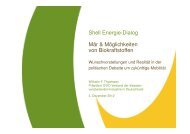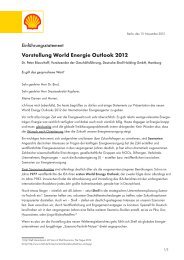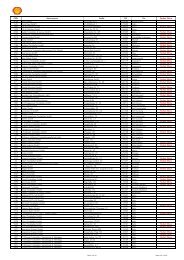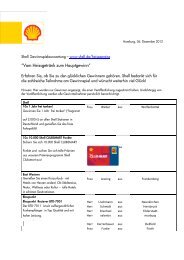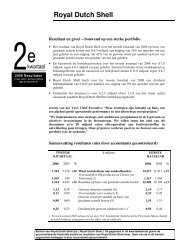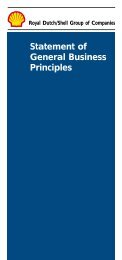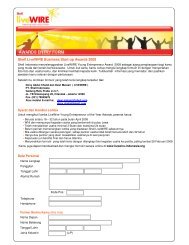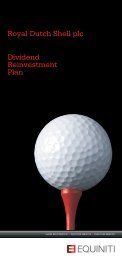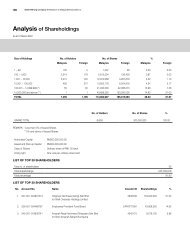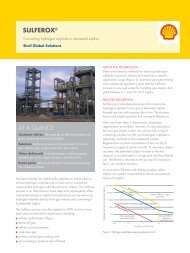ENVIRONMENTAL STATEMENT BARDOLINO DEVELOPMENT
ENVIRONMENTAL STATEMENT BARDOLINO DEVELOPMENT
ENVIRONMENTAL STATEMENT BARDOLINO DEVELOPMENT
Create successful ePaper yourself
Turn your PDF publications into a flip-book with our unique Google optimized e-Paper software.
Bardolino Development Environmental Statement<br />
3.4.7 Cementing Chemicals<br />
Cement is used to secure the steel casing in the well bore, and the cementing chemicals are<br />
used to modify the technical properties of the cement slurry. During cementing operations,<br />
the majority of these chemicals are left downhole but a small quantity of cement may be<br />
discharged onto the seabed around the top of the casing. However, the chemicals used will<br />
be contained within inert cement and will therefore not pose a threat to the marine<br />
environment. Careful estimates of the final volume of the hole will be made during drilling,<br />
and the volume of cement used will be adjusted accordingly to minimise the risk of excess<br />
cement being squeezed out of the hole onto the seabed.<br />
A number of chemicals will need to be added to the cement. The exact chemical constituents<br />
required to formulate the cement will be confirmed during the final stages of well design.<br />
They will be included in the detailed chemical risk assessment of the PON 15B which will be<br />
submitted to BERR at least 28 days prior to commencement of drilling activities as required<br />
by the Offshore Chemical Regulations 2002.<br />
3.4.8 Contingency Chemicals<br />
Contingency chemicals will be held on the rig for use in unplanned events. Potential<br />
applications would be to free a stuck drill string, or seal highly porous or fractured zones to<br />
prevent the uncontrolled loss of drilling fluid. A detailed risk assessment for contingency<br />
chemical use will be submitted to BERR as required by the Offshore Chemical Regulations<br />
2002.<br />
3.4.9 Handling Mud and Cuttings<br />
Once on board the rig, drill cuttings are removed from the drilling mud by solids control<br />
equipment. Where LTOBM is used the mud and cuttings will be treated by the solids control<br />
equipment before being intercepted by a collection device. The cuttings will be transferred<br />
from the solids control equipment and then either dried and collected in skips ready for<br />
transfer to a supply vessel, or slurrified and pumped directly to the bulk tanks of a supply<br />
vessel for transport to shore. Once onshore the cuttings are processed until they have very<br />
low oil content and then disposed of. The base oil residue recovered during this process is<br />
returned to the mud company.<br />
Shell’s “Ship to Shore Cuttings Disposal Guidelines” will be followed during the planned<br />
LTOBM phase. In the event of unexpected hole conditions (e.g. faster than expected<br />
penetration rates), equipment breakdown or failure, or operational and logistics downtime due<br />
to adverse weather conditions, contingency arrangements will be in place to permit storage of<br />
cuttings on board the rig until normal operations are resumed. If necessary, unless personnel<br />
safety or installation integrity is threatened, drilling will cease in preference to the discharge of<br />
LTOBM-coated cuttings to sea. However, in the event of a major safety incident where no<br />
compromise on safety risks to personnel or asset can be made, the contingency will exist to<br />
divert limited quantities of cuttings overboard.<br />
3.4.10 Well Clean-up and Testing Operations<br />
Once drilling has been completed, the Bardolino well will be circulated clean prior to<br />
completion, and then tested. The exact chemicals required for these processes will be<br />
included in the chemical risk assessment of the PON 15B as required by the Offshore<br />
Chemical Regulations 2002. Hydrocarbons produced during the well flow clean-up and<br />
testing will be flared.<br />
The aim of well clean-up is to remove detritus from the well prior to running the completion. It<br />
also removes solids that could impair both mechanical operations in the well bore and<br />
reservoir performance once the well has been perforated.<br />
The potential emissions from well clean-up and testing of the development well have been<br />
calculated based on a total testing and clean-up period of 48 hours with a maximum of 15,000<br />
bbls of oil, with an expected GOR of 870 scf/bbl (<br />
Table 3.4). This represents a worst case for emissions. There is no intention to perform an<br />
extended well test, and it is likely that the quantity of oil flared during well clean-up and testing<br />
April 2008 Page 3-11



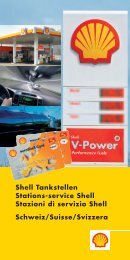
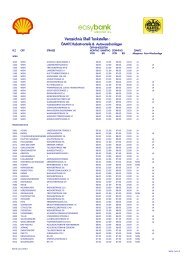
![Download Shell AutoGas Stationen [Stand: Januar 2013] (PDF](https://img.yumpu.com/9982753/1/190x245/download-shell-autogas-stationen-stand-januar-2013-pdf.jpg?quality=85)
